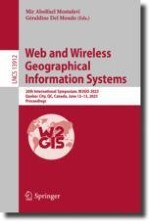2023 | Book
Web and Wireless Geographical Information Systems
20th International Symposium, W2GIS 2023, Quebec City, QC, Canada, June 12–13, 2023, Proceedings
Editors: Mir Abolfazl Mostafavi, Géraldine Del Mondo
Publisher: Springer Nature Switzerland
Book Series : Lecture Notes in Computer Science
